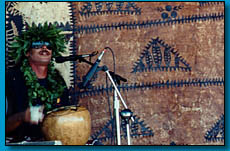|
Aloha k‚kou (Aloha to All of Us),
Yesterday, with great anticipation --
yes, with bated breaths -- we, my husband and I who were born in Hawai`i
fifty years ago and raised there, went to see LILO
& STITCH at our local theatre, hoping for its unmitigated
success and yet knowing it could be yet another dirty bomb unwittingly
directed against the Hawaiian culture.
We were utterly impressed with LILO
& STITCH's shining truth and loved and thoroughly enjoyed
every minute of the galactic high adventure and its down-to-Earth
(literally) endearing story, brimming full of Aloha of the real,
day-to-day variety, not the syrupy, touristy stuff. Having been raised
with Disney movies, ourselves, we were delighted with its high caliber
Disney feel and animation mastery, especially the stunningly gorgeous
water-color visuals of our homeland.
Co-directors Chris
Sanders and Dean De Blois and
producer Clark Spencer bolstered our faith
in the next generation of moviemakers. I dare say that they are uniquely
enlightened young people, wise beyond their years.
|

Chris Sanders & Dean De Blois
on beautiful
Kaua`i
|

Clark Spencer
|
|
Graphics, courtesy
of Disney |
Certainly, this movie
is not yet another run-of-the-mill, Hawaiian-themed fantasy that my
generation has come to expect out of Hollywood. We've seen, rolled our
eyes upward, and laughed at the ludicrousness of too many hurriedly
slapped together movies based on deluded, overly-dramatized or
white-washed, idealized visions and versions of Hawaiian culture and its
people.
Instead, it was clearly evident to us
that the research that went into LILO AND STITCH
was done with thoroughness, sincerity, concern and care.
The result? A movie with a huge
sensitivity, concern and Aloha for our endangered Hawaiian and local
culture, which, with a combination of "attitude" and
sweetness, captures the authentic spirit and genuine warmth, and inner
and outer beauty of Hawai`i, especially its unique Aloha Spirit and
valuing of `ohana
(family).

Aunty D's `Ohana at the "Big O" (for
`Ohana)
at Disney's California Adventure
In its unique, far-reaching way, LILO
and STITCH -- and Disney -- will help to perpetuate Hawaiian
ways, beingness, and arts, as well as our one-of-a-kind local culture. I
loved the snippets of pidgin, for most of us, our first language. Tia
Carrere and Jason Scott Lee
(Sylvia's son!) were perfect in their voice roles as Nani
and K‚wika (David). For a change, true locals playing local roles with
every truthful and subtle nuance.

Loving Hawaiian music as I do, I am
particularly grateful for the inclusion of authentic Hawaiian
musicianry: the mesmerizing, lively chants by real-life Hawaiian
chanter, Mark Keali`i Ho`omalu, were
right-on.

Mark Keali`i Ho`omalu
Graphic, courtesy of cultures.com
The casting of real-life kumu hula (hula master)
Kunewa Mook as the voice of the hula teacher in the movie was exactly
pono (right and proper); his input on depicting hulas as it is actually
danced, and not the swishy hula gibberish of past Hollywood movies was
greatly appreciated by us, his peers.

|
Graphic,
courtesy of Honolulu Star-Bulletin and by DENNIS ODA
Kaui Kamanao, left, Paleka Leina`ala Mattos (Kunewa's sister,
now in spirit), Malia Ann Kawailanam‚lie Petersen and Kunewa
Mook share a hug.
>> Star-Bulletin
article |
And singing by the
Kamehameha Schools
Children's Chorus -- you must have indigenous blood to go
to school there -- could not have been truer or more delightful. Ahh....
I am going out to buy the CD ASAP!
(Update: It is FABULOUS!)

Graphic,
courtesy of the
Kamehameha
Schools Children's Chorus
Of course, we grew up with Elvis'
classic tunes, so we absolutely loved the resurrection of his songs as
well as Wynonna's rendition of
"Burning Love." A perfect balance to the Hawaiian music.
It is pono,
which means not only "right and proper" in Hawaiian, but
"balanced."
|

Elvis in Hawai`i
Hawaii
|

Wynonna Judd
|
We spotted only one glaring mistake: the shaka
("all is cool") sign as depicted in the movie at the
end. They got the fingers right, but the way they did it, it's only half
of the shaka sign. As it was, it stopped as the Texas Longhorn symbol.
Locals then swivel their wrist, 180 degrees, completing the local sign
with the BACK of the hand toward the viewer.

Oh well, as we say in
Hawai`i: "Ain't no big t'ing, braddah." Mebbe the moviemakers
can fix that faux pas ?
A big MAHALO (THANK YOU) to all involved,
viewers included, who make LILO & STITCH the sharing movie it is.
Spread the Aloha.
Me ke Aloha,
Aunty D,
http://hawaiianlanguage.com

|